Scientists and engineers at the Superconducting Quantum Materials and Systems Center, hosted by the U.S. Department of Energy’s Fermi National Accelerator Laboratory, have achieved reproducible improvements in superconducting transmon qubit lifetimes with record values of 0.6 milliseconds. The result was achieved through an innovative materials technique that eliminated a major loss source in the devices.
These results have been published in Nature Partner Journal Quantum Information.
Quantum devices such as qubits are critical for storing and manipulating quantum information. The qubit lifespan, known as coherence time, determines how long data can be stored and processed before an error occurs. This phenomenon, called quantum decoherence, is a key obstacle to operating quantum processors and sensors.
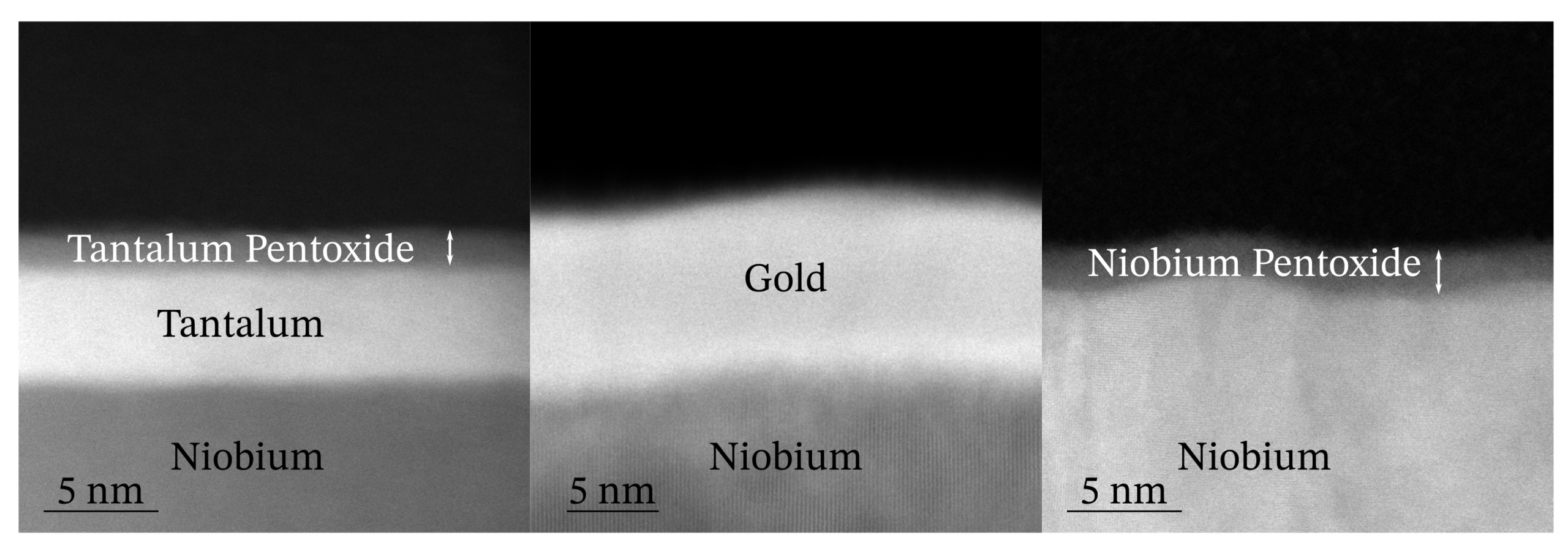
Electron microscopy images show the surface of the various superconducting transmon qubits fabricated at SQMS with the novel encapsulation technique. The qubit with the native niobium oxide is compared to the tantalum and gold capping layers that prevent the re-growth of the niobium oxide. Graphic: SQMS Center, Fermilab
The novel process called “surface encapsulation” protects key layers of the qubit during fabrication and prevents the formation of problematic, “lossy” oxides at the surfaces and interfaces of these devices. By carefully investigating and comparing various materials and deposition techniques, SQMS researchers have studied different oxides that lead to longer qubit lifetimes and fewer losses.
“SQMS is pushing the envelope of qubit performance,” said Alexander Romanenko, a senior scientist at Fermilab and SQMS Center’s quantum technology thrust leader. “These efforts show that undergoing a systematic review of processes and materials and attacking what matters most first is the key to pushing qubit coherence. Pursuing device fabrication and characterization, hand in hand with materials science is the right recipe to deepen our scientific understanding of loss mechanisms and improve quantum devices in the future.”
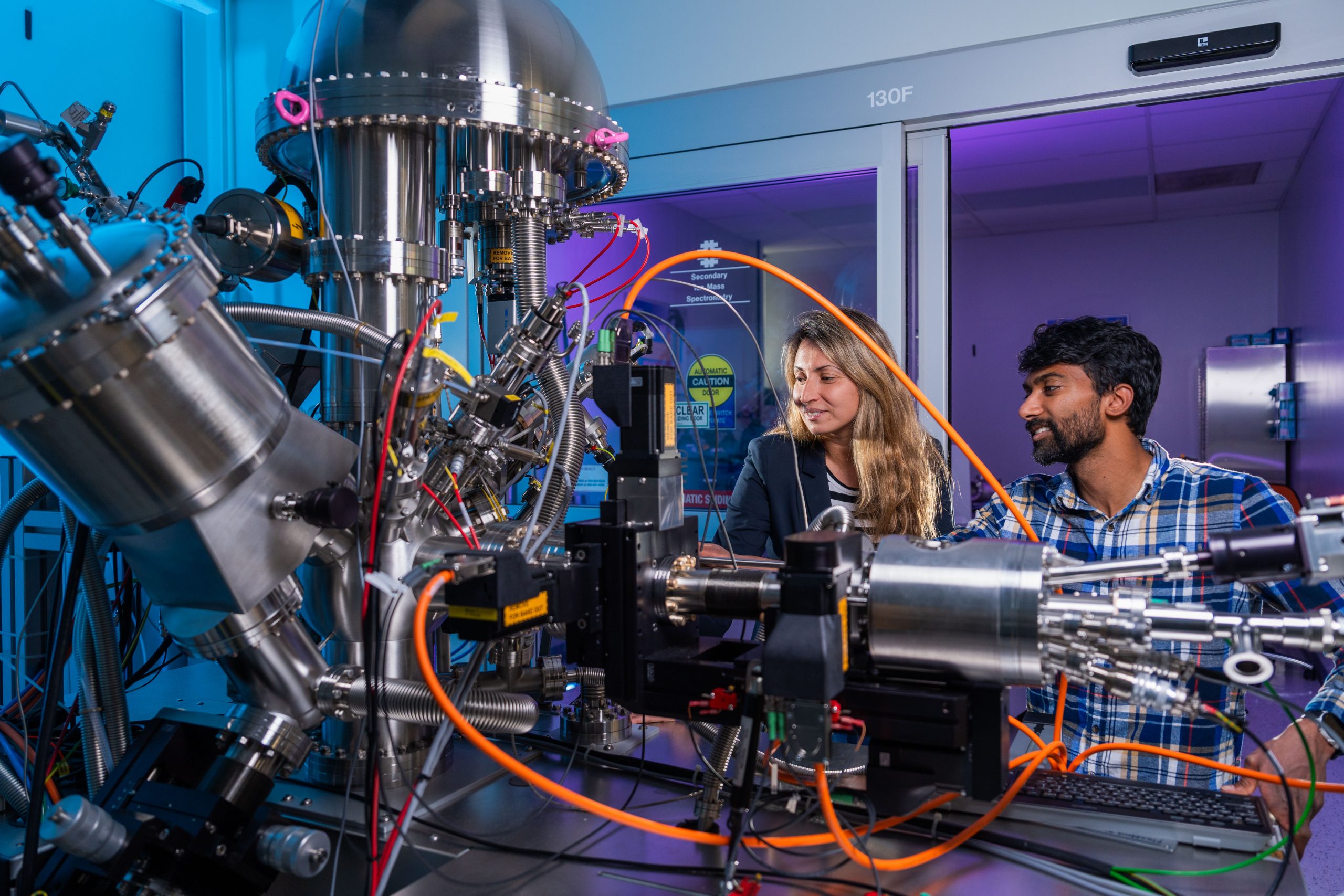
Anna Grassellino, Fermilab senior scientist and SQMS Center director, and Akshay Murthy, SQMS Materials Focus area leader and Materials Characterization group leader, apply state-of-the-art characterization techniques in the Materials Science Lab, such as X-ray photoelectron spectroscopy and time-of-flight secondary ion mass spectrometry, to examine the effectiveness of niobium surface capping. Photo: Ryan Postel, Fermilab
The biggest hurdle for qubits: coherence time
There are many types of qubits. These basic building blocks of quantum computers process information differently — and potentially faster — than classical computers. The longer a qubit can store quantum information, the better its potential for use in a quantum computer.
Since its inception in 2020, the SQMS research team has focused on understanding the source of errors and decoherence in transmon qubits. This type of qubit is patterned on a chip consisting of a metallic niobium layer on top of a substrate, such as silicon or sapphire. Many consider these superconducting qubits to be the most advanced platform for quantum computers. Tech companies in the United States and around the world are also exploring them.
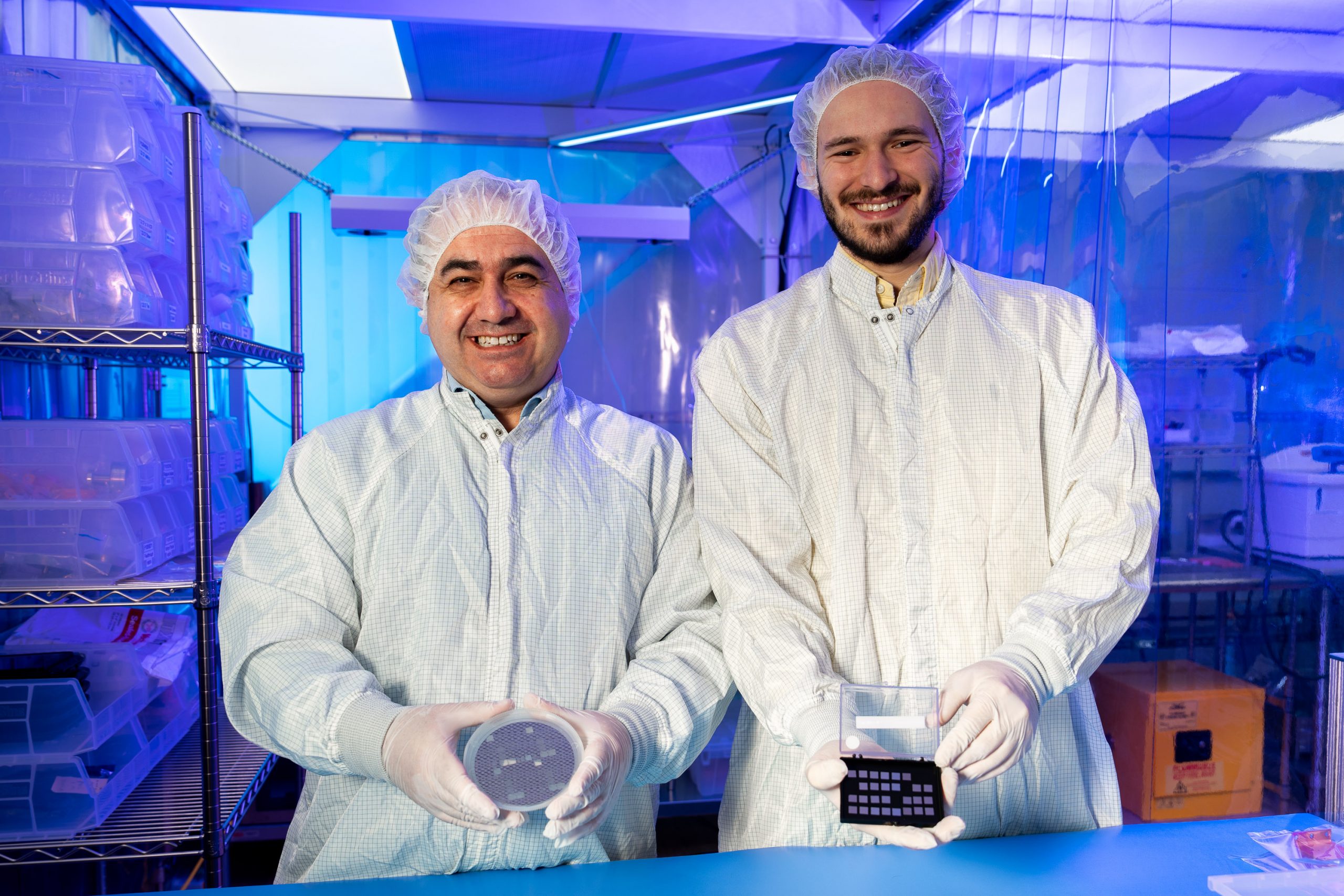
Mustafa Bal, nanofabrication group leader at the Fermilab SQMS division and leader of the SQMS Center national nanofabrication taskforce (left) and graduate student Francesco Crisa hold transmon chips of leading performance they produced at the Pritzker Nanofabrication Facility. Photo: Dan Svoboda, Fermilab
However, scientists must still overcome some challenges before quantum computers can fulfill their promise of solving previously unsolvable problems. Specific properties of the materials used to create these qubits can lead to the decoherence of quantum information. At SQMS, developing a deeper scientific understanding of these properties and loss mitigation strategies is an active area of research.
To make qubits last longer, focus on the materials
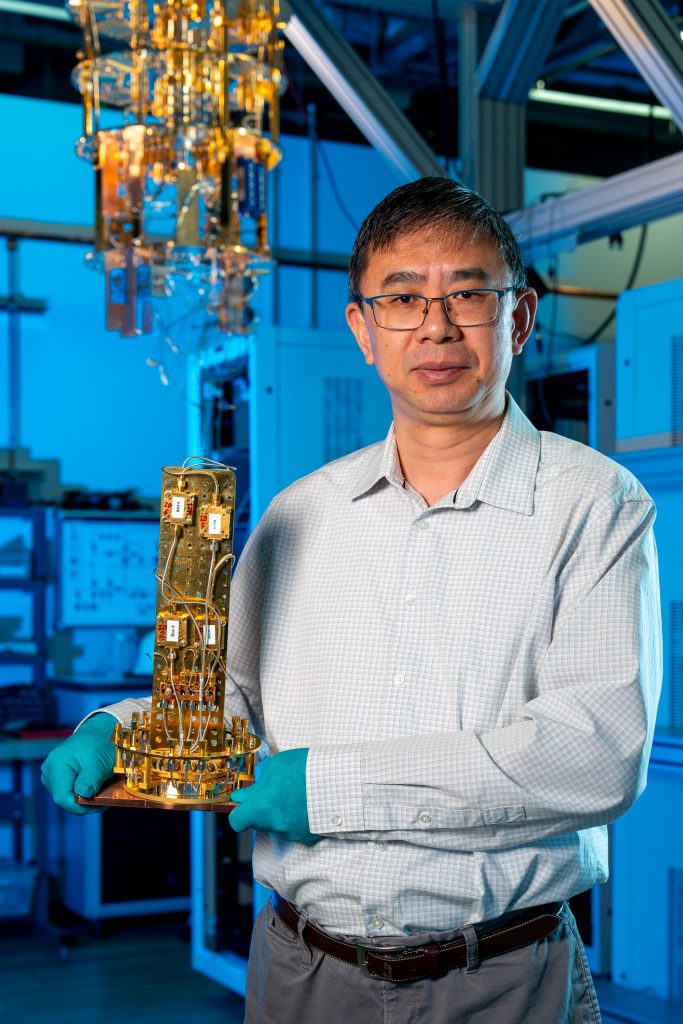
Shaojiang Zhu, qubit design and simulation group leader at the Fermilab SQMS Division, holds transmon qubits prepared with the surface encapsulation technique ready to be measured at the SQMS Quantum Garage at Fermilab. Photo: Dan Svoboda, Fermilab
SQMS scientists studying the losses in transmon qubits pointed to the niobium surface as the primary culprit. These qubits are fabricated in a vacuum, but when exposed to air, an oxide forms on the surface of niobium. Though this oxide layer is thin — only about 5 nanometers — it is a major source of energy loss and leads to shorter coherence times.
“Our prior measurements indicate that niobium is the best superconductor for these qubits. While the metal losses are near zero, the niobium surface oxide is problematic and the main driver of losses in these circuits.” Romanenko said.
SQMS scientists proposed encapsulating the niobium during fabrication so it would never be exposed to air and, therefore, its oxide would not form. While they had a hypothesis on which materials would work best for capping, determining the optimal material required a detailed study. So, they systematically tested this technique with different materials, including aluminum, tantalum, titanium nitride, and gold.
With each capping layer attempt, SQMS scientists analyzed the materials using several advanced characterization techniques at material science labs at Fermilab, Ames National Laboratory, Northwestern University, and Temple University. Qubit performances were measured inside a dilution refrigerator at the SQMS Quantum Garage at Fermilab. This cryogenic device cools qubits to just a tick above absolute zero. The results demonstrated that the researchers could prepare qubits with 2 to 5 times coherence improvement compared to samples prepared without a capping layer (containing the niobium oxide layer).
The team found that the capping process improved coherence times for all materials explored in the study. Of these materials, tantalum and gold proved to be the most effective for enabling a higher coherence time, with an average of 0.3 milliseconds and maximum values as high as 0.6 milliseconds. These results shed further light on the nature, hierarchy, and the mechanism of losses in these qubits. They are found to be driven by the presence of amorphous oxides and interfaces.
“When fabricating a qubit, there are many variables, more or less hidden, that can impact performance,” said Mustafa Bal, a scientist at Fermilab and head of the SQMS nanofabrication group and task force. “This is a first-of-its-kind study that very carefully compares one material change and one process change at a time, on a chip of a fixed geometry, across different fabrication facilities. This approach ensures that we develop reproducible techniques for improvement in qubit performance.”
Coherence times: how far we have come
The teams fabricated and tested qubits in different facilities as part of the SQMS Center’s National Nanofabrication Taskforce. Fermilab led the way with the SQMS nanofabrication group headed by Bal, making qubits at the Pritzker Nanofabrication Facility at the University of Chicago. Other facilities included Rigetti Computing, a quantum computing company with a quantum foundry, and the National Institute of Standards and Technology Boulder Laboratories. Both are flagship partners at the SQMS Center. Fabricating the chip at Rigetti’s commercial foundry proved that the technique is easily reproducible and scalable for the industry.
“At Rigetti Computing, we want to make the best possible superconducting qubits to make the best possible quantum computers, and extending the lifetimes of qubits in a reproducible way has been one of the hardest problems,” said Andrew Bestwick, senior vice president of quantum systems at Rigetti. “These are among the leading transmon coherence times that the field has been able to achieve on a two-dimensional chip. Most importantly, the study has been guided by the scientific understanding of qubit loss, leading to reproducibility across different labs and in our fabrication facility.”
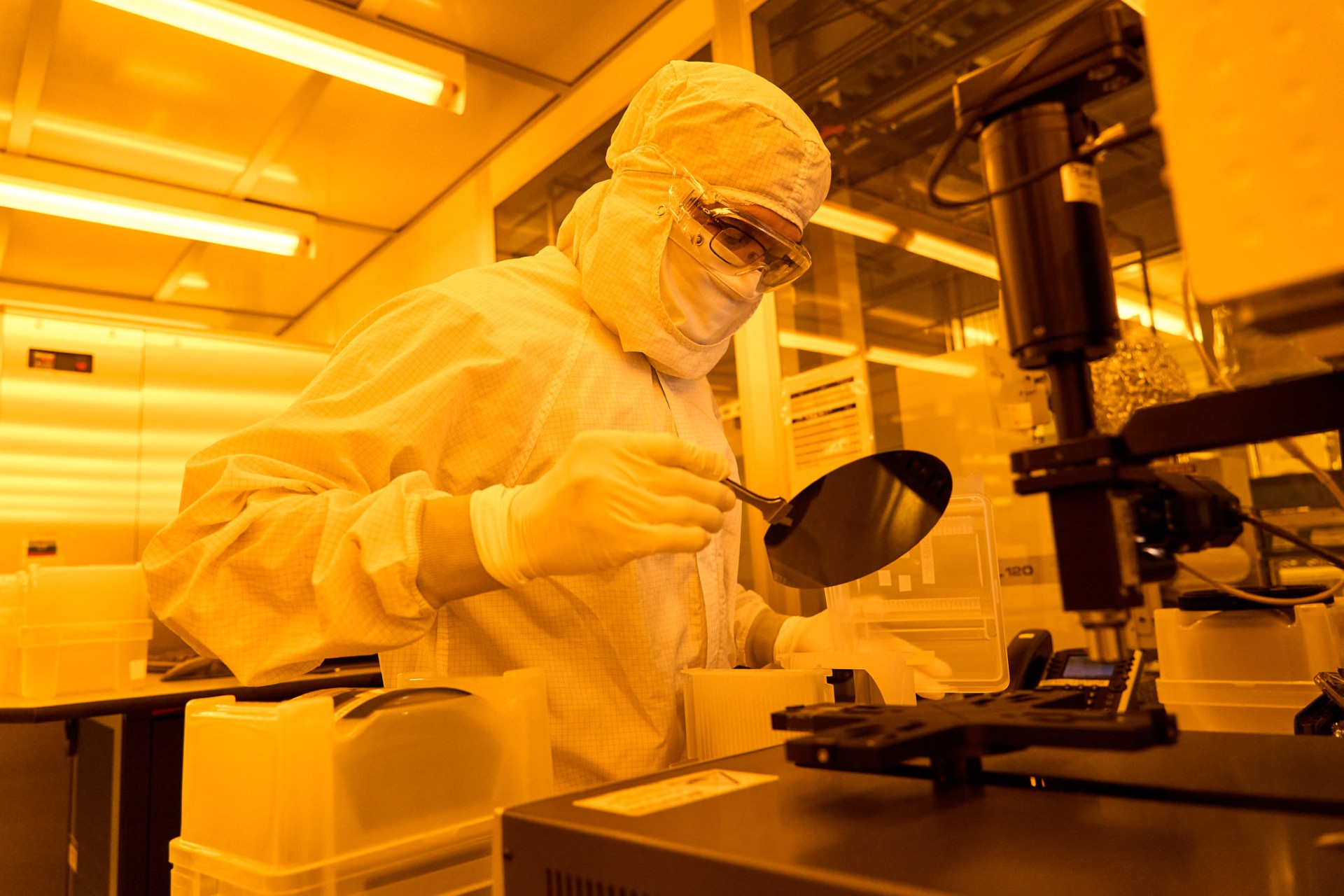
Rigetti’s Fab-1 is the industry’s first dedicated and integrated quantum device and manufacturing facility, located in Fremont, California. The qubit surface encapsulation technique was easily reproduced at the Rigetti facilities. Photo: Rigetti Computing
At NIST, scientists are interested in using quantum technology to make fundamental measurements of photons, microwave radiation, and voltage. “This has been a great team effort and a good planting of a flag that shows both how far we have come and the challenges that remain to be faced,” said Peter Hopkins, a physicist at NIST who leads the superconductive electronics group and is a lead member of the SQMS Center National Nanofabrication Taskforce.
Following this work, SQMS researchers continue to push qubits’ performance frontier further. The next steps include engineering creative and robust nanofabrication solutions for applying this technique to other transmon qubit surfaces to eliminate all lossy interfaces present in these devices. The underlying substrate upon which these qubits are prepared also represents the next major source of losses. SQMS researchers are already hard at work characterizing and developing better silicon wafers or other lower-loss substrates suitable for quantum applications.
Moreover, SQMS scientists are working to ensure these advances in the coherence studies can be preserved in more complex chip architectures with several interconnected qubits.
SQMS Quantum Technology Roadmap
Given the breadth of the SQMS Center collaboration, the Center’s vision and mission are multi-fold. The researchers seek to improve the performance of the building blocks of a quantum computer and apply these innovations in mid-scale prototypes of quantum processors.
At SQMS, two main superconducting quantum computing platforms are under exploration: 2D transmon qubit chip-based and 3D cavity-based architectures. For the chip-based processors, SQMS researchers work hand in hand with industry partners such as Rigetti to advance performance and scalability of these platforms.
Currently, SQMS researchers from Fermilab and Rigetti have co-developed a 9-qubit processor incorporating these surface encapsulation advances. The chip is being installed in the SQMS Quantum Garage at Fermilab. Its performance will be evaluated and benchmarked in the upcoming weeks.
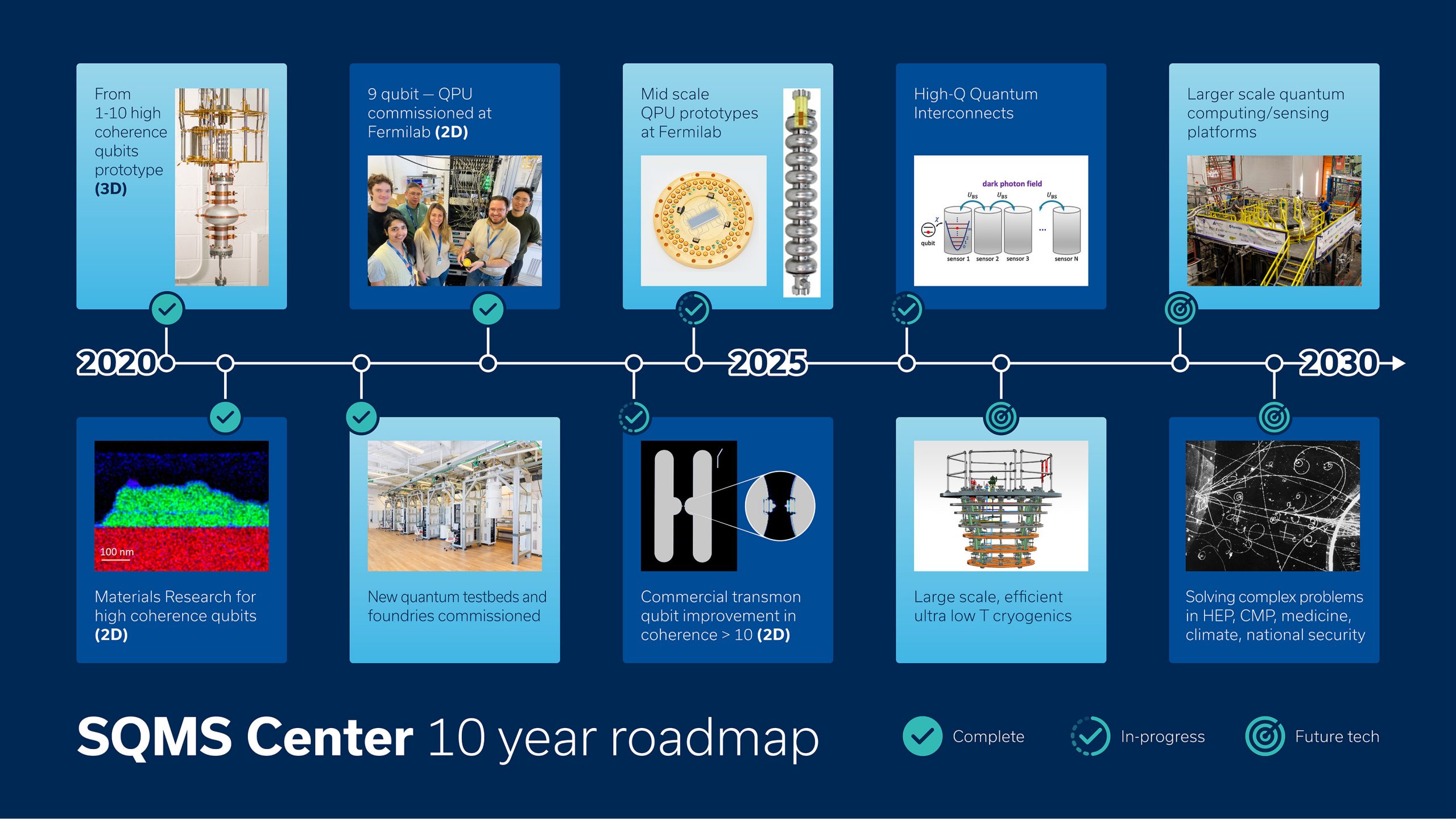
This timeline shows shows a roadmap for the SQMS Center’s development of 2D transmon qubits and 3D cavity-based platforms. Graphic: Samantha Koch, Fermilab
For the 3D cavity-based platforms, Fermilab scientists have been working to integrate these qubits with superconducting radio-frequency cavities. Scientists initially developed these cavities for particle accelerators and Fermilab builds upon decades of experience in making the world’s best SRF cavities, demonstrating photon lifetimes of up to 2 seconds. When combined with transmon qubits, these cavities can also be used as building blocks of quantum computing platforms. Such an approach promises potentially better coherence, scalability and qubit connectivity. To date, Fermilab scientists have achieved up to several milliseconds of coherence in these cavity-qubit combined systems.
“We know how to make the world’s best cavities, but the success of the 3D platforms under construction at Fermilab also heavily depends on how far we can keep pushing the performance of these transmon qubits used to control and manipulate the quantum states in the cavities,” said Romanenko. “So, it’s kind of two birds with one stone. As we push to advance our transformational 3D technologies, we also work alongside industry to enable important advances in 2D chip-based quantum computing platforms.”
The Superconducting Quantum Materials and Systems Center at Fermilab is supported by the DOE Office of Science.
The Superconducting Quantum Materials and Systems Center is one of the five U.S. Department of Energy National Quantum Information Science Research Centers. Led by Fermi National Accelerator Laboratory, SQMS is a collaboration of more than 30 partner institutions — national labs, academia and industry — working together to bring transformational advances in the field of quantum information science. The center leverages Fermilab’s expertise in building complex particle accelerators to engineer multiqubit quantum processor platforms based on state-of-the-art qubits and superconducting technologies. Working hand in hand with embedded industry partners, SQMS will build a quantum computer and new quantum sensors at Fermilab, which will open unprecedented computational opportunities. For more information, please visit sqmscenter.fnal.gov.
Fermi National Accelerator Laboratory is America’s premier national laboratory for particle physics research. A U.S. Department of Energy Office of Science laboratory, Fermilab is located near Chicago, Illinois, and operated under contract by the Fermi Research Alliance LLC. Visit Fermilab’s website at https://www.fnal.gov and follow us on Twitter @Fermilab.
Representatives of the São Paulo Research Foundation, including Executive Director Carlos Américo Pacheco, Scientific Director Márcio de Castro Silva Filho and General Coordinator of Humanities and Arts Sylvio Canuto, visited the U.S. Department of Energy’s Fermi National Accelerator Laboratory in April to gain an overview of the lab’s scientific portfolio.
The foundation, known as FAPESP, is a state funding agency in São Paulo, Brazil that supports research projects across various scientific disciplines in higher education and research institutions.
The visit commenced with a discussion led by Fermilab Director Lia Merminga along with representatives from the lab’s science and engineering teams. The focus of the talk was Fermilab’s Long-Baseline Neutrino Facility and the Deep Underground Neutrino Experiment.
Ron Ray, the deputy project director for LBNF/DUNE in the U.S., presented an overview of Fermilab’s flagship experiment. This ambitious project involves directing neutrinos from Fermilab’s campus to detectors situated a mile underground in Lead, South Dakota.
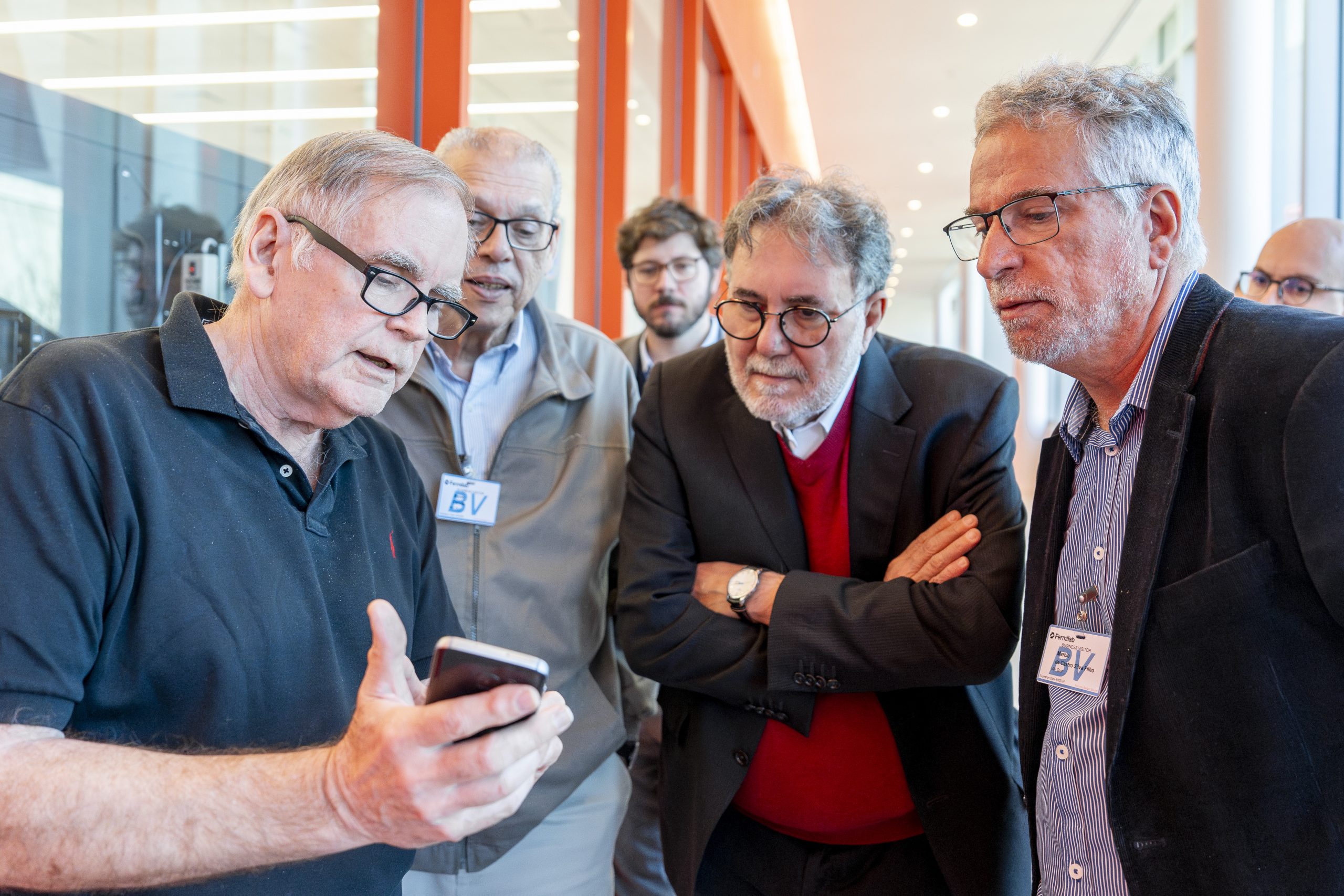
At the Integrated Engineering Research Center, Andrew Lathrop of Fermilab shows an image of the first cosmic ray muon events in a 450 p.s.i. liquid nitrogen cooled 16 Skipper CCD to (left to right) Sylvio Canuto, Carlos Américo Pacheco, and Márcio de Castro Silva Filho of FAPESP. Photo: Dan Svoboda, Fermilab
To gain insight into Fermilab’s neutrino research, the group toured the Integrated Engineering Research Center accompanied by David Montanari, far detector cryogenics manager for LBNF/DUNE U.S. They met with Andrew Lathrop, a senior technical specialist, to view a Skipper CCD, known for its unprecedented sensitivity to weak electrical signals. This technology can help study rare neutrino interactions and potentially provide insights into dark matter.
Jennifer Raaf, Fermilab’s head of the neutrino division, showcased the new lab space in the IERC dedicated to assembling and testing modules produced in Switzerland for the DUNE ND-LAr near detector. This detector is crucial for DUNE’s physics sensitivity.
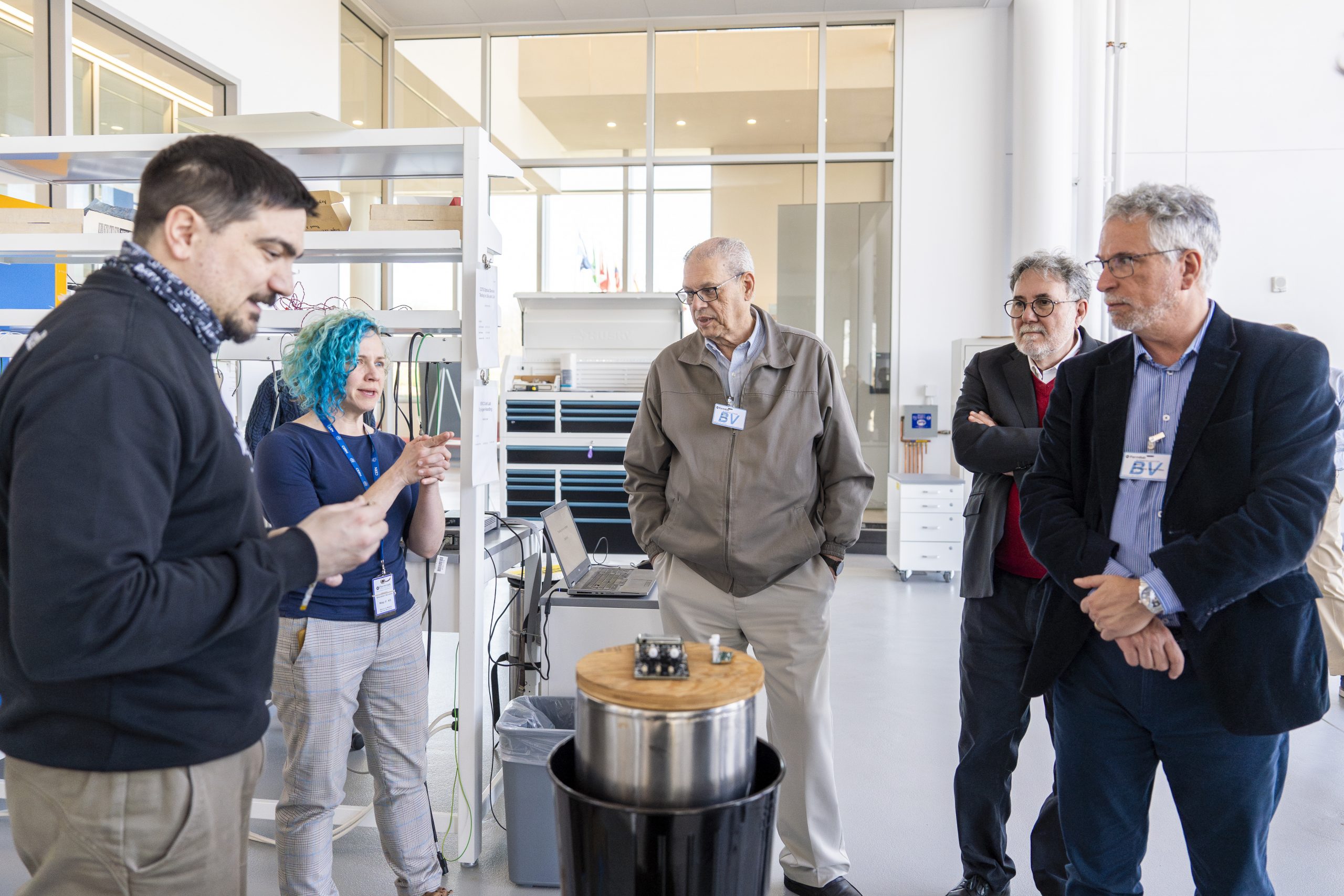
Left to right: Dante Totani and Jennifer Raaf of Fermilab discuss neutrino detector technologies with Sylvio Canuto, Carlos Américo Pacheco, and Márcio de Castro Silva Filho. Photo: Dan Svoboda, Fermilab
Dante Totani, a postdoctoral researcher from the University of California Santa Barbara, works in this lab space to develop X-Arapuca photodetector cold electronics for DUNE. As neutrinos from Fermilab’s accelerator complex interact with argon nuclei, charged particles are produced. The X-Arapuca detectors collect scintillation light generated during this process to help reconstruct neutrino-argon collisions. This system, developed by Brazilian researchers, is a key feature of the DUNE far detector.
Saravan Chandrasekaran, in-kind contribution coordinator for the Proton Improvement Plan-II accelerator project, led the next segment of the tour. Chandrasekaran highlighted Fermilab’s research and development in accelerator technology — including PIP-II, the particle accelerator designed to provide the world’s most intense beam of neutrinos for the LBNF/DUNE experiment.
Fermilab researchers develop electromagnets and superconducting cavities using materials like niobium-tin, which lose electrical resistance when cooled. Fermilab will contribute 16 of these ultra-strong magnets to the High-Luminosity Large Hadron Collider Upgrade Project at CERN.
Giorgio Apollinari, project manager for the HL-LHC upgrade, and Maria Baldini, a scientist, discussed the project’s scope with the group, emphasizing the magnets’ increased current capacity for creating powerful magnetic fields in the LHC upgrade.
The representatives then learned about Fermilab’s quantum computing research at the Superconducting Quantum Materials and Systems Center, exploring how superconducting cavities, used in accelerators, might serve as quantum computing devices by storing photons briefly. The SQMS Center is one of five National Quantum Information Science Research Centers established by Congress in 2018.
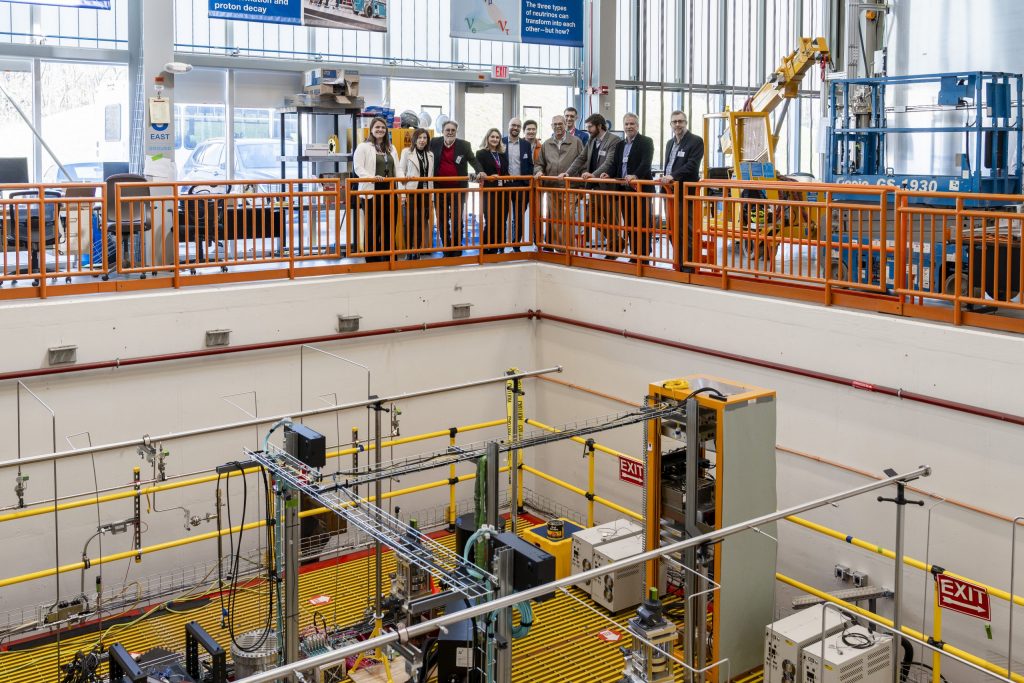
FAPESP representatives stand with members of the Fermilab scientific and engineering staff at the Short Baseline Near Detector. Photo: Dan Svoboda, Fermilab
The tour ended at the Short Baseline Near Detector at Fermilab. Roza Doubnik, a senior cryogenic engineer and technical liaison with Brazil on the LBNF/DUNE project, highlighted SBND’s role as one of Fermilab’s three liquid argon neutrino detectors for the program and its prototyping connection to the LBNF/DUNE cryostats.
Ornella Palamara, co-spokesperson for SBND, detailed that the detector will capture over a million neutrino-argon interactions yearly using Liquid Argon Time Projection Chamber technology and the X-Arapuca photon light system, similar to DUNE.
Fermi National Accelerator Laboratory is supported by the Office of Science of the U.S. Department of Energy. The Office of Science is the single largest supporter of basic research in the physical sciences in the United States and is working to address some of the most pressing challenges of our time. For more information, please visit science.energy.gov.
The U.S. Department of Energy’s Fermi National Accelerator Laboratory welcomes Greg Stephens as the lab’s new chief operating officer beginning May 6, 2024.
Stephens brings more than 35 years of experience in commercial, academic, international and U.S. government operations, working in project management, business administration, environment, safety and health, and engineering. He has served at 11 of the 17 U.S. national laboratories. At each lab, Stephens took on a wide array of roles including project and program manager, chief engineer, chief information officer, chief technical officer and operations director.
“We are delighted to have Greg Stephens join Fermilab in leading the operation of the lab,” said Fermilab Director Lia Merminga. “His extensive experience, including at many of the national laboratories, and leadership roles, will be a huge asset in his leadership of our laboratory operations toward the safe, secure, efficient and effective execution of our mission.”

Fermilab welcomed Greg Stephens as the lab’s new chief operating officer on May 6, 2024. Photo: Amentu
Most recently, Stephens was vice president for Amentum’s Technical Services. Here he led a diverse staff that delivered operations, engineering, maintenance, safety, quality assurance, risk assessment, business and project optimization, and management services.
Under his leadership, the division supported a wide array of high-hazard chemical, biological and nuclear operations customers from around the world, including U.S. and international laboratories, research and development entities, commercial companies and emergency preparedness institutions.
“I am excited and honored to join the Fermilab team, the premier particle physics laboratory in the U.S.,” Stephens said. “I look forward to collaborating with the talented Fermilab employees to drive innovation and continue the excellent scientific research. I believe there is an exciting future at Fermilab and look forward to bringing my passion and expertise to this team as we capture the opportunities ahead.”
Stephens is an electrical engineer with a degree from Clemson University. He began his career with DuPont de Nemours, Inc. in the Engineering Services Division and with General Electric in the Simulation and Space Systems Manufacturing Management Program. He also had numerous project and program management assignments at Westinghouse, Washington Group International, URS, AECOM and Amentum.
Stephens has served on the Board of Directors for Helping Hands of Aiken and the United Way of Aiken County while also on the Engineering Advisory Board for the University of South Carolina at Aiken. He and his wife Jane have three grown children and one grandchild.
Fermi National Accelerator Laboratory is supported by the Office of Science of the U.S. Department of Energy. The Office of Science is the single largest supporter of basic research in the physical sciences in the United States and is working to address some of the most pressing challenges of our time. For more information, please visit science.energy.gov.
